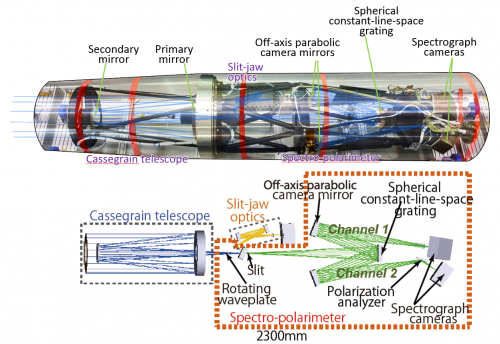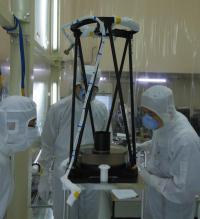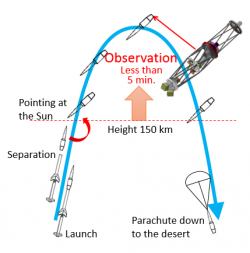CLASP was successfully launched
 CLASP launch (NASA/MSFC)
CLASP launch (NASA/MSFC)The Chromospheric Lyman-Alpha Spectro-Polarimeter (CLASP) is a sounding rocket experiment to observe the Sun through Lyman-alpha line emissions. Because the Lyman-alpha line is absorbed by the Earth's atmosphere, the instrument needed to be raised above the atmosphere. CLASP was successfully launched to space from White Sands in the U.S.A. at 11:01 local time on September 3.
What is CLASP?
CLASP aims to infer the nature of the magnetic fields in the chromosphere and the transition region of the Sun, by measuring the polarization of light caused by the Hanle effect. The magnetic fields in the photosphere can be measured through the Zeeman effect. However for the chromosphere and the transition region, where the field strengths are weak, it is difficult to use the Zeeman effect to measure their magnetic fields. The Hanle effect provides an attractive alternative.
The CLASP instrument installed in the rocket skin is shown below with a composite image. The instrument consists of the telescope and the spectro-polarimeter.

CLASP Launch
Dr. Kano (CLASP project J-side PI) said, "Everything was the perfect in this sounding rocket experiment: the rocket flight, the instrument's on-flight performances, and the pointing operation. CLASP observed one point on the solar disk without any jitter/drift motion, as if time stopped. Since I saw the excellent data in real time, I am so excited and look forward to the detail analysis from now by ourselves."
Dr. Narukage (Instrument Scientist) said, "The CLASP sounding rocket took a perfect data set as response to our effort at 7-year development!! Though we just starts the detail analysis of the obtained data, I have already confirmed that our data will remain in the solar observation history!!"
Dr. Ishikawa (Project Scientist) said, "I was very excited with the launch of CLASP. When I looked at data from the telemetry, I was very happy that data was excellent. Moreover, I also remembered these seven years which I spend with CLASP and I realized that we finally come here!!!! I am looking forward to performing the detail data analysis very much."
Regarding the use of images and movies on the page concerned, please visit the page here. The credits of images and movies on this page are “NAOJ/JAXA” unless explicitly stated to the contrary. Regarding images and movies on this page the credits of which are “NAOJ/JAXA”, "NAOJ/JAXA/MSU", or “NAOJ, JAXA, NASA/MSFC”, terms of use for Copyrighted Works owned by NAOJ can be applied. In using the images and movies, the credits should be given.


